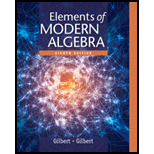
Let G be the group and H the subgroup given in each of the following exercises of Section 4.4. In each case, is H normal in G?
Exercise 3 b. Exercise 4 c. Exercise 5
d. Exercise 6 e. Exercise 7 f. Exercise 8
Section 4.4
Let H be the subgroup {e,β} of the octic group D4.
Find the distinct left cosets of H in D4, write out their elements, partition D4 into left cosets of H, and give [D4:H].
Find the distinct right cosets of H in D4, write out their elements, and partition D4 into right cosets of H.
Let H be the subgroup {e,Δ} of the octic group D4.
Find the distinct left cosets of H in D4, write out their elements, partition D4 into left cosets of H, and give [D4:H].
Find the distinct right cosets of H in D4, write out their elements, and partition D4 into right cosets of H.
Let H be the subgroup {e,Δ} of the octic group D4.
Find the distinct left cosets of H in D4, write out their elements, partition D4 into left cosets of H, and give [D4:H].
Find the distinct right cosets of H in D4, write out their elements, and partition D4 into right cosets of H.
Let H be the subgroup {(1),(2,3)} of S3.
Find the distinct left cosets of H in S3, write out their elements, partition S3 into left cosets of H, and give [S3:H].
Find the distinct right cosets of H in S3, write out their elements, and partition S3 into right cosets of H.
In Exercises 7 and 8, let G be the multiplicative group of permutation matrices {I3,P3,P32,P1,P4,P2} in Example 6 of Section 3.5
Let H be the subgroup of G given by H={I3,P4}={(100010001),(001010100)}.
Find the distinct left cosets of H in G, write out their elements, partition G into left cosets of H, and give [G:H].
Find the distinct right cosets of H in G, write out their elements, and partition G into right cosets of H.
Let H be the subgroup of G given by H={I3,P3,P23}={(100010001),(010001100),(001100010)}.
Find the distinct left cosets of H in G, write out their elements, partition G into left cosets of H, and give [G:H].
Find the distinct right cosets of H in G, write out their elements, and partition G into right cosets of H.
Trending nowThis is a popular solution!

Chapter 4 Solutions
Elements Of Modern Algebra
- I write with prove one-to-one linear Sanction but not onto Lexample.) b) write with Prove on to linear function but not oh-to-on (example). c) write with prove example x=y St Xandy two linear space over Sielad F.arrow_forwardFind the sample space. Sunscreen SPF 10, 15, 30, 45, 50 Type Lotion, Spray, Gelarrow_forwardFor each graph below, state whether it represents a function. Graph 1 24y Graph 2 Graph 3 4 2 -8 -6 -4 -2 -2 2 4 6 Function? ○ Yes ○ No ○ Yes ○ No Graph 4 Graph 5 8 Function? Yes No Yes No -2. ○ Yes ○ No Graph 6 4 + 2 4 -8 -6 -4 -2 2 4 6 8 Yes -4++ Noarrow_forward
- Practice k Help ises A 96 Anewer The probability that you get a sum of at least 10 is Determine the number of ways that the specified event can occur when two number cubes are rolled. 1. Getting a sum of 9 or 10 3. Getting a sum less than 5 2. Getting a sum of 6 or 7 4. Getting a sum that is odd Tell whether you would use the addition principle or the multiplication principle to determine the total number of possible outcomes for the situation described. 5. Rolling three number cubes 6. Getting a sum of 10 or 12 after rolling three number cubes A set of playing cards contains four groups of cards designated by color (black, red, yellow, and green) with cards numbered from 1 to 14 in each group. Determine the number of ways that the specified event can occur when a card is drawn from the set. 7. Drawing a 13 or 14 9. Drawing a number less than 4 8. Drawing a yellow or green card 10. Drawing a black, red, or green car The spinner is divided into equal parts. Find the specified…arrow_forwardAnswer the questionsarrow_forwardHow can I prepare for me Unit 3 test in algebra 1? I am in 9th grade.arrow_forward
- Asked this question and got a wrong answer previously: Third, show that v3 = (−√3, −3, 3)⊤ is an eigenvector of M3 . Also here find the correspondingeigenvalue λ3 . Just from looking at M3 and its components, can you say something about the remaining twoeigenvalues? If so, what would you say?arrow_forwardDetermine whether the inverse of f(x)=x^4+2 is a function. Then, find the inverse.arrow_forwardThe 173 acellus.com StudentFunctions inter ooks 24-25/08 R Mastery Connect ac ?ClassiD-952638111# Introduction - Surface Area of Composite Figures 3 cm 3 cm 8 cm 8 cm Find the surface area of the composite figure. 2 SA = [?] cm² 7 cm REMEMBER! Exclude areas where complex shapes touch. 7 cm 12 cm 10 cm might ©2003-2025 International Academy of Science. All Rights Reserved. Enterarrow_forward
 Elements Of Modern AlgebraAlgebraISBN:9781285463230Author:Gilbert, Linda, JimmiePublisher:Cengage Learning,
Elements Of Modern AlgebraAlgebraISBN:9781285463230Author:Gilbert, Linda, JimmiePublisher:Cengage Learning,
